- Removable Partial Dentures
- Tooth Extraction: Post-Operative Instructions
- Your Wisdom Teeth
- Taking Care of Your Teeth and Gums
- Basic Flossing
- Do You Have a Cracked Tooth?
- Periodontal Disease: Your Complete Guide
- Basic Brushing
- Periodontal Disease: Keep Your Gums Healthy
- Fluoride: Nature's Cavity Fighter
- Hate To Floss? 3 Other Ways to Clean Between Your Teeth
- Handling Your Child's Dental Emergency
- Get the Facts about Mouth and Throat Cancer
- Oral Health and the HPV Vaccine
- Do You Grind Your Teeth?
- Tooth Decay in Baby Teeth
- Do You Have Sleep Apnea?
- Your Single Tooth Implant
- Your Child's Teeth
- Tobacco and Oral Health
- Seal Out Decay
- Temporomandibular Disorders (TMD)
- Healthy Smiles for Mother and Baby
- Healthy Mouth, Healthy Body: Making the Connection
- Baby Teeth: When They Come In, When They Fall Out
- Thumb Sucking, Finger Sucking and Pacifier Use
- Sip and Snack All Day? Risk Decay!
- 3 Tooth Replacement Options
- Tooth Erosion
- Tooth Decay
- Treating Cavities
- Should You Take Antibiotics before Your Dental Treatment?
- Mouthguards and Sports Safety
- Gum Recession Causes and Treatments
- Dental X-Ray Exams
- Diabetes and Your Oral Health
- Scaling and Root Planing
- Pregnancy and Oral Health
- Your Dentures
- Your Child's First Visit to the Dentist
- Root Canal Therapy Can Save Your Tooth
- Periodontal Disease - Don't wait until it hurts
- Why Do I Need a Bridge?
- Why Do I Need a Crown?
- Your Smile - An Owner's Manual
- Dental Sealants Protecting teeth, preventing decay
- Happiness is a Healthy Smile
- Dental Veneers - Improve Your Smile
- Tooth Whitening for a Brighter Smile
- Why Baby Teeth Are Important
- Dry Mouth
- Sealant Quick Reference
- Caries en Dientes de Leche
- Why Doesn't My Insurance Pay for This?
- Periodontal Maintenance: Stay on Top of Gum Disease
- Flossing Quick Reference
- Brushing Quick Reference
- Your Child's Teeth: Ages 6–12
- Your Child's Teeth: From Birth to Age 6
- Dental Implants: Are they an option for you
- Mouth Sores and Spots
- Sipping, Snacking and Decay
- Improving Your Smile
- Your Child's First Dental Visit
Brush your teeth twice a day and for two minutes each time. Use a toothpaste that contains fluoride (FLOOR-eyed), a natural mineral that helps make your teeth stronger. It’s also important to clean your teeth with floss or another between-the-teeth cleaner every day. This helps remove bits of food and plaque from between the teeth and under the gum line that a toothbrush can’t reach.
Choose a soft-bristled toothbrush in a size and shape that fits your mouth comfortably. Replace your toothbrush every three months, or sooner if the bristles are worn or frayed. Worn toothbrushes won’t clean teeth properly.
Both manual and powered toothbrushes are effective at removing plaque. If you have hand, arm, or shoulder problems that limit movement, a powered toothbrush may be easier for you to use.
Supervise teeth brushing for children up to age 6—make sure they use the right amount of toothpaste and spit the toothpaste out. Begin brushing children’s teeth as soon as the first tooth comes in and until the age of 3 years, using a smear of toothpaste the size of a grain of rice. After age 3, use a pea-sized amount.
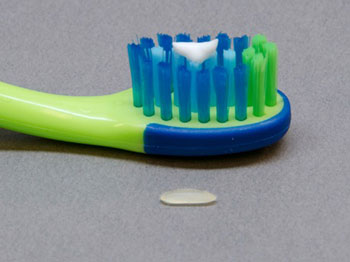
For children under three years old.
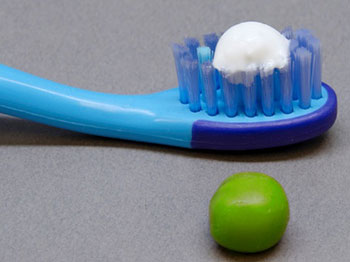
For children three to six years old.
When choosing a toothbrush, floss and fluoride toothpaste, look for products that show the American Dental Association Seal of Acceptance. This means that the product meets the ADA’s standards for safety and effectiveness.
Basic Level Brushing
Talk to your dentist or dental hygienist about the best way to brush your teeth.
Here are a few tips to help you start a good routine:
Step 1
Place your toothbrush against your gums at a 45-degree angle. Move the brush back and forth gently and in short strokes, about as wide as each of your teeth.
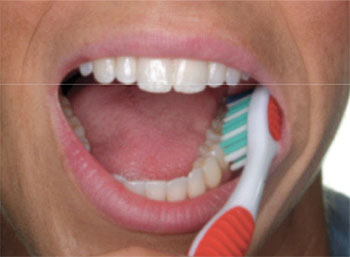
Step 2
Brush the outer tooth surfaces, keeping the toothbrush at an angle to the gums.
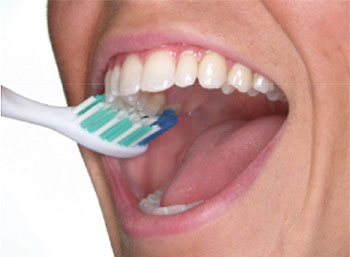
Step 3
Brush the inner tooth surfaces.
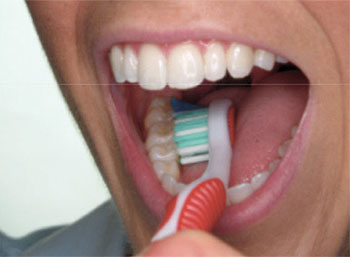
Step 4
Brush the chewing surfaces.
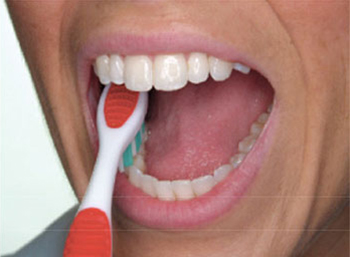
Step 5
Use the top part of the brush to clean the inside surface of the top and bottom front teeth. Use a gentle up-and-down motion.
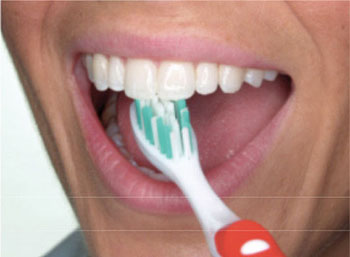
Eating a healthy diet, limiting snacks and visiting your dentist regularly will help you keep your smile healthy for years to come.
Visit Our Office
Office Hours
- MON8:30 am - 5:00 pm
- TUE8:30 am - 5:00 pm
- WEDClosed
- THUClosed
- FRI8:30 am - 5:00 pm
- SAT9:00 am - 2:00 pm
- SUNClosed